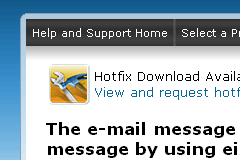Transmit 3.6.7 Released
November 26, 2008
 The latest version of my favorite Mac-based FTP client, Transmit, has just been released. Updates include:
The latest version of my favorite Mac-based FTP client, Transmit, has just been released. Updates include:
- Re-worked preview drawer to avoid unnecessary file transfers and cancels, thus avoiding possible transfer stalls
- Fixed a possible crash when changing selection quickly and right-clicking
- Fixed S3 uploads with files greater than 2 GB
- Fixed a problem in which files may be deleted when moving them into a subfolder
Why Can’t I Email My PowerPoint Presentation?
November 17, 2008
 About two or three times a week I am asked, “Why can’t I email my presentation to John?” Of course, I know that our email server is running fine, so I jump to the most likely problem: attachments. I ask if they are sending any attachments along with the email. Most people answer yes with a “how did you know?” sound in their voice.
About two or three times a week I am asked, “Why can’t I email my presentation to John?” Of course, I know that our email server is running fine, so I jump to the most likely problem: attachments. I ask if they are sending any attachments along with the email. Most people answer yes with a “how did you know?” sound in their voice.
The most popular attachment in my shop is the good ‘ole PowerPoint presentation. I’ll admit, PowerPoint can be a wonderful and powerful tool. In the hands of a pro, you can make some really nice presentations. In the hands of a beginner (and even a novice), a PowerPoint presentation can quickly turn into a bloated mess, especially if digital pictures and scanned images are used.
In the past, this wasn’t much of a problem. Really large image files were non-existent until affordable digital cameras came on the scene. Now people are putting two great tools together with an inconvenient result. You see, digital pictures tend to have rather large file sizes. Adding digital pictures and scanned images to your PowerPoint presentation can quickly make them too large to send through most email systems. Read more
Copy Directory Structure Without Files Using XCOPY Command
October 31, 2008
 I’m not a DOS guy. I do much better with a graphical user interface (GUI). However, recently I came across an issue where the XCOPY command came in handy.
I’m not a DOS guy. I do much better with a graphical user interface (GUI). However, recently I came across an issue where the XCOPY command came in handy.
On my Windows XP machine had a folder that contained over 500 sub-directories. I needed to copy the directory structure without copying the files contained in these directories. After a good bit of searching on my own, I turned to my good friend Jared who pointed me to the XCOPY command.
XCOPY is short for Extended Copy and is the big brother to the copy command found in MS-DOS. It provides many more options for copying multiple files and directories from one drive to another or across a network. Adding certain characters will allow you modify your copy command. Read more
My Computer is Slow
October 20, 2008
 There is a phrase I have heard so many times as an IT guy that, if I was given a dollar per occurrence, I would have retired years ago. It seems to be very popular among computer users and, honestly, it drives me insane.
There is a phrase I have heard so many times as an IT guy that, if I was given a dollar per occurrence, I would have retired years ago. It seems to be very popular among computer users and, honestly, it drives me insane.
The phrase, you may have guessed, is some variant of “My computer is slow.” Just typing those words makes me fidget in my chair.
Read more
Which Mouse Click?
October 13, 2008
 The mouse is a simple device, but there is a surprising amount of different ways to use it. Knowing how to use it for a particular task will make you more efficient at your job and can even help your computer to run more smoothly.
The mouse is a simple device, but there is a surprising amount of different ways to use it. Knowing how to use it for a particular task will make you more efficient at your job and can even help your computer to run more smoothly.
If you’ve ever wondered why there are 4 copies of Outlook open on your screen, please read on!
Optimizing PDF Files
September 12, 2008
 PDF files that are created for press and printing can have high resolution and large file size. This can make it difficult to view these files on the Web or send them via email. In some earlier versions of Acrobat, you could simply go to File > Reduce File Size and you were done. The Reduce File Size option was a quick and easy way of downsizing your PDFs, but with the introduction of Acrobat 8 we’re presented with a much more full-featured tool; the PDF Optimizer.
PDF files that are created for press and printing can have high resolution and large file size. This can make it difficult to view these files on the Web or send them via email. In some earlier versions of Acrobat, you could simply go to File > Reduce File Size and you were done. The Reduce File Size option was a quick and easy way of downsizing your PDFs, but with the introduction of Acrobat 8 we’re presented with a much more full-featured tool; the PDF Optimizer.
Keep in mind that performing this Optimization can result in reduction of resolution and compressing certain file components. This is not recommended for files that are bound for press.
Email Headers Not Printing in Outlook
August 8, 2008
 I recently experienced a curious problem with printing emails. It seems that if you are running Outlook Express, Outlook XP (2002), or Outlook 2003, trouble may arise when you upgrade to Internet Explorer 7.
I recently experienced a curious problem with printing emails. It seems that if you are running Outlook Express, Outlook XP (2002), or Outlook 2003, trouble may arise when you upgrade to Internet Explorer 7.
I can’t say that it happens every time and I don’t really know what causes the issue, but the right combination of Outlook and Internet Explorer 7 can cause the headers to not appear on printed emails.
Read more
Lightroom 2 – Better External Hard Drive Support
August 1, 2008
 The release of Adobe Lightroom 2 is packed with tons of useful new features and capabilities. One note-worthy addition is the extended support for external hard drives.
The release of Adobe Lightroom 2 is packed with tons of useful new features and capabilities. One note-worthy addition is the extended support for external hard drives.
If you’re like me, you probably have at least one external hard drive used as a back-up device or for additional photo storage. In Lightroom 1, all imported photos were visually clumped together in a often-confusing folder list. Version 2 of Lightroom gives us a much more meaningful and informative view of our photo folders and attached devices.
FTP – File Transfer Protocol
July 30, 2008
 Just a few months ago, I was taking a short vacation down in Florida with my wife’s family. It was the first time our little nieces had ever been to the ocean, so I was sure to take lots and lots of pictures. Every evening, after we had gone out to one of the many great places to eat, I would dump all of my pictures from my compact flash card onto my laptop.
Just a few months ago, I was taking a short vacation down in Florida with my wife’s family. It was the first time our little nieces had ever been to the ocean, so I was sure to take lots and lots of pictures. Every evening, after we had gone out to one of the many great places to eat, I would dump all of my pictures from my compact flash card onto my laptop.
A lot of people would stop there, but I like to have several copies of all my important files. So, before turning in for the night, I would open up my favorite FTP program, connect to the FTP server running on my computer at home (600 miles away!), and transfer all of the precious photos I had taken that day. Indeed, FTP is a great tool that anyone with a broadband connection should use.
Read more
Windows Remote Desktop Connections
July 21, 2008
 Recently, my wife has been considering doing a little computer work for her office from home. Since they don’t exactly have an IT department, I get to help them out from time to time. At first, the folks at her office believed that they needed to buy some specialized software to facilitate the remote connection. I was glad to tell them that they already had all they need: Windows XP Pro, and a static IP address.
Recently, my wife has been considering doing a little computer work for her office from home. Since they don’t exactly have an IT department, I get to help them out from time to time. At first, the folks at her office believed that they needed to buy some specialized software to facilitate the remote connection. I was glad to tell them that they already had all they need: Windows XP Pro, and a static IP address.
Remote Desktop Connection is a utility that comes with Windows XP. It allows a user to connect to another computer remotely via a network connection or the Internet. When connecting from within a local network (like in an office environment), you can use the Computer Name to connect to another computer. If you are connecting to another computer via the Internet, you must know that computer’s public IP address.
Read more


